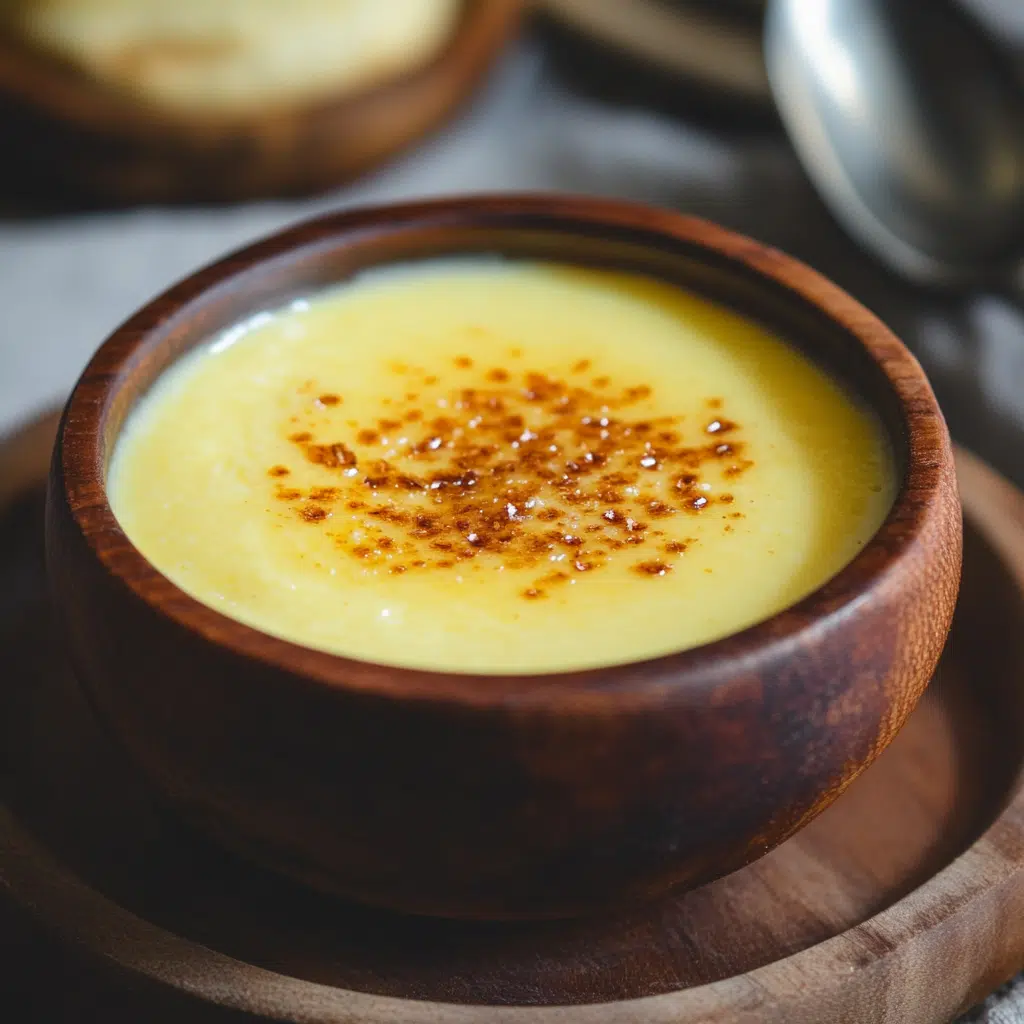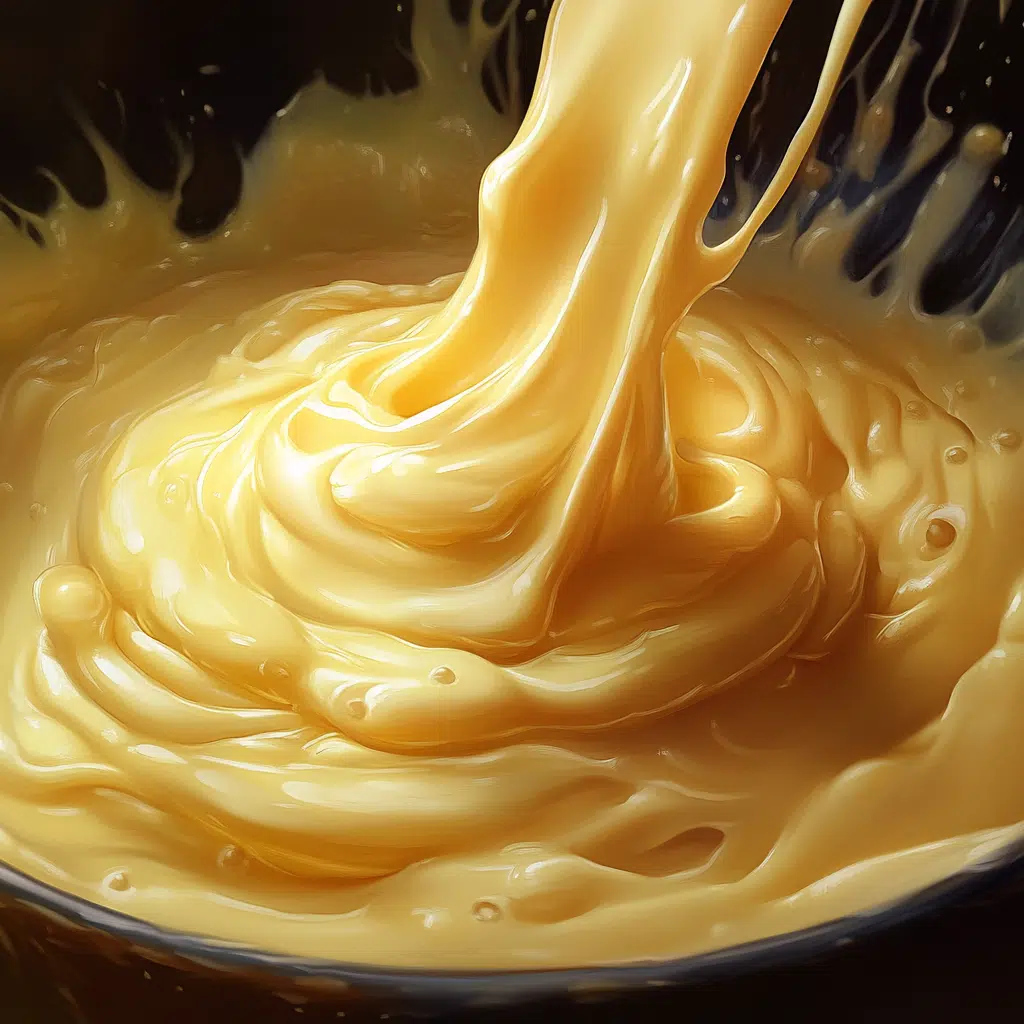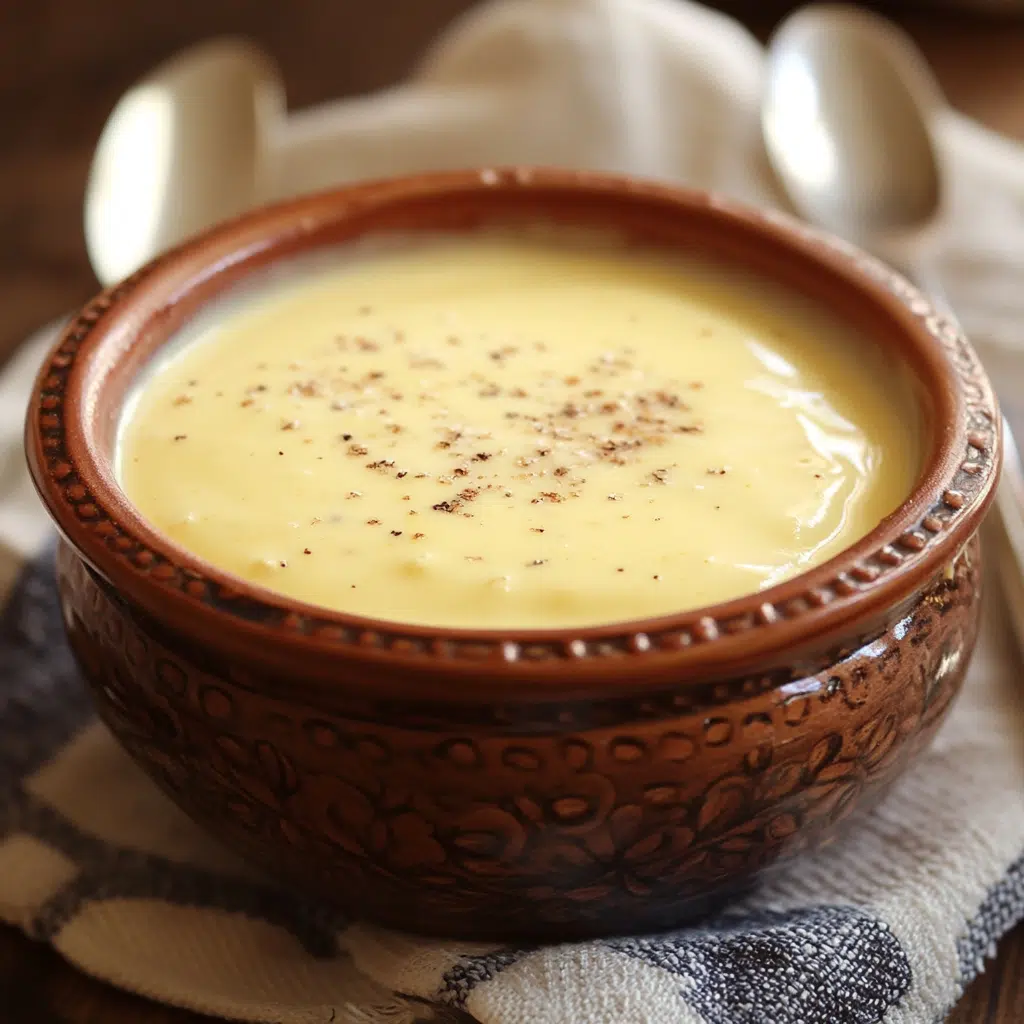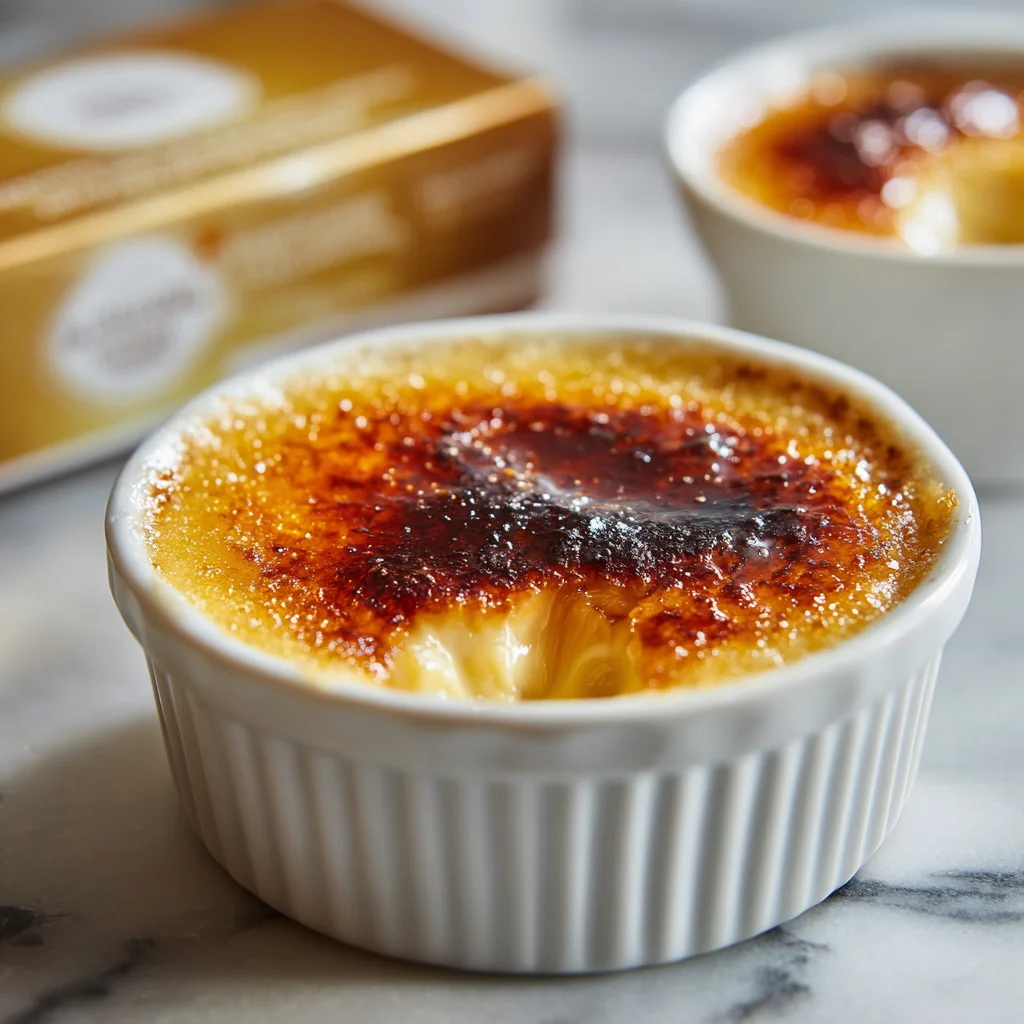Introduction to Crème Brûlée
What is Crème Brûlée? – A Brief History and Overview

Crème brûlée, often translated as “burnt cream,” is a timeless French dessert that has captured the hearts of dessert lovers worldwide. Its origins can be traced back to 17th-century Europe, with France, England, and Spain each laying claim to its creation. The modern version we recognize today, with its creamy custard base and crisp caramelized sugar topping, is closely associated with French cuisine. let’s discover if you can use Store-Bought custard for Crème Brûlée.
The base of crème brûlée is a simple custard made with cream, egg yolks, sugar, and vanilla. This custard is baked gently, often in a water bath, to ensure a luxuriously smooth and silky texture. Once cooled, a thin layer of sugar is added on top and caramelized using a kitchen torch or broiler. This process creates a golden, glassy crust that provides a satisfying contrast to the creamy custard beneath.
Historically, crème brûlée first appeared in printed recipes in the late 1600s, with one of the earliest known mentions in François Massialot’s 1691 cookbook. Over the centuries, it has evolved into a symbol of indulgence and elegance, gracing the menus of fine-dining restaurants and becoming a popular treat for home cooks alike.
To learn more about the essential components of this dessert, explore What is Crème Brûlée Made Of?.
Key Characteristics of Crème Brûlée
Crème brûlée is defined by its unique combination of textures and flavors, making it a standout dessert for any occasion. Here are its key characteristics:

- Silky Custard Base
The heart of crème brûlée is its velvety custard, which is rich and creamy without being overly sweet. The custard is infused with vanilla for a subtle yet indulgent flavor profile. - Crispy Caramelized Topping
The hallmark of crème brûlée is its caramelized sugar crust. This thin, crackly layer is created by sprinkling sugar on top of the custard and torching it until it melts and hardens. Breaking through this crust with a spoon is one of the dessert’s most satisfying moments. - Elegant Presentation
Crème brûlée is typically served in small, shallow ramekins, which allow for an even layer of caramelized sugar. Its simplicity in presentation highlights the dessert’s sophistication. - Temperature Contrast
One of the most delightful aspects of crème brûlée is the temperature contrast between the cold custard and the warm, caramelized topping. This interplay enhances the overall sensory experience.
With its perfect balance of textures, flavors, and visual appeal, crème brûlée remains a favorite among dessert enthusiasts. For insights into what makes this dessert so special, read What Does Crème Brûlée Taste Like?.
What is Crème Brûlée Made Of?
Crème brûlée is a deceptively simple dessert that relies on a few key ingredients to deliver its rich flavor and silky texture:

- Cream and Milk: The primary base for the custard.
- Egg Yolks: Provide structure and richness.
- Sugar: Both for sweetening the custard and creating the caramelized topping.
- Vanilla: Enhances the flavor, often through vanilla extract or beans.
The custard is cooked slowly and carefully to ensure a smooth, creamy texture, then topped with a layer of sugar that is caramelized to form a crisp shell. For a more detailed breakdown of the essential components, read What is Crème Brûlée Made Of.
Can Store-Bought Custard Replace Homemade?
Advantages of Store-Bought Custard
Using store-bought custard offers:
- Convenience: Eliminates the need to whisk egg yolks, temper cream, and bake custard in a water bath.
- Time Savings: Preparation time is significantly reduced, making it ideal for busy schedules.
- Consistency: Store-bought custards are processed for uniformity, reducing the risk of curdling or separating.
Limitations of Store-Bought Custard for Crème Brûlée
- Flavor Depth: Pre-made custards are often less rich and flavorful compared to their homemade counterparts.
- Texture Challenges: Some store-bought custards may be too thin, requiring thickening before use.
If you’re curious about the nuances between custard and crème brûlée, explore What’s the Difference Between Crème Brûlée and Custard?.
How to Make Store-Bought Custard for Crème Brûlée
Using store-bought custard for crème brûlée is straightforward, but a few adjustments can help elevate the final result. Here’s a detailed guide:
Ingredients
- 2 cups of store-bought custard: Vanilla-flavored works best.
- 4 ramekins: Choose heatproof ramekins for baking or broiling.
- 4 tablespoons of sugar: Use granulated sugar for caramelizing.
- Optional Additions: Vanilla bean paste, liqueur, or citrus zest to enhance flavor.
Instructions
- Prepare the Custard:
- Pour the custard into a bowl and stir in your chosen flavor enhancers, such as vanilla bean paste or a teaspoon of orange zest. These additions help mimic the flavor complexity of homemade custard.
- Fill the Ramekins:
- Divide the custard evenly among the ramekins, leaving a bit of space at the top. Smooth the surface with a spoon or spatula to ensure even caramelization.
- Caramelize the Sugar:
- Sprinkle one tablespoon of sugar evenly over the surface of each custard.
- Use a kitchen torch to caramelize the sugar until it turns golden brown and forms a crisp crust. If you don’t have a torch, place the ramekins under a hot broiler for 2–3 minutes, watching carefully to prevent burning.
- Cool and Serve:
- Allow the caramelized sugar to cool for a few minutes until it hardens. Serve immediately to enjoy the contrast between the cold custard and warm, crunchy topping.
For more tips on mastering this step, refer to The Secret of Crème Brûlée.
Benefits and Challenges of Using Store-Bought Custard
Benefits
- Simplicity: Store-bought custard eliminates multiple steps, such as tempering and baking, making it a beginner-friendly option.
- Accessibility: Ready-made custards are widely available in grocery stores, often in a variety of flavors.
- Time Efficiency: Ideal for last-minute dessert preparation.
Challenges
- Runny Consistency:
Some custards are thinner than homemade versions. To thicken, whisk in a cornstarch slurry (1 teaspoon cornstarch dissolved in 1 tablespoon of cold milk) and heat the custard gently until it thickens. - Limited Flavor:
Pre-made custards may taste bland compared to homemade. Enhance the flavor by adding a splash of liqueur like Grand Marnier or a pinch of ground cinnamon. - Caramelization Issues:
The custard must be firm enough to support the caramelized sugar topping. Ensure the custard is well-chilled before caramelizing.
Challenges with Store-Bought Custard for Crème Brûlée
While using store-bought custard for crème brûlée is a convenient option, it comes with its own set of challenges. Understanding these limitations can help you make the necessary adjustments to achieve the best results.
Textural Limitations
One of the primary issues with store-bought custard is its texture, which often differs significantly from the ideal consistency required for crème brûlée. Traditional crème brûlée custard is thick, silky, and firm enough to support the caramelized sugar topping. In contrast, store-bought custards can sometimes be:
- Too Thin: Many pre-made custards are designed to be poured or spooned, making them too runny for a dessert that requires structural integrity.
- Inconsistent: Depending on the brand, the consistency may vary, leading to uneven results when caramelizing the sugar.
To address these textural issues, you can:
- Thicken the Custard: Add a cornstarch slurry (1 teaspoon cornstarch mixed with 1 tablespoon of milk) and gently heat the custard until it reaches the desired consistency.
- Use a Stabilizer: Incorporate a small amount of dissolved gelatin for a firmer custard base.
These adjustments ensure that the custard can hold up under the weight of the sugar crust while maintaining its creamy texture.
Differences in Flavor and Richness
Another notable challenge lies in the flavor profile of store-bought custard. Homemade custard is celebrated for its rich, natural flavors, often derived from fresh cream, egg yolks, and high-quality vanilla. Store-bought options, however, can fall short due to the following reasons:
- Artificial Additives: Many store-bought custards include stabilizers, preservatives, or artificial flavorings, which can result in a less authentic taste.
- Lack of Depth: The flavor may feel one-dimensional compared to the layered richness of homemade custard.
- Overly Sweetened: Some store-bought varieties are pre-sweetened to a degree that overpowers the subtle flavors of the dessert.
To enhance the flavor of store-bought custard:
- Add vanilla bean paste or extract to replicate the depth of homemade custard.
- Experiment with a splash of liqueur, such as Grand Marnier or Amaretto, for added complexity.
- Incorporate a pinch of citrus zest or a hint of spice like cinnamon or nutmeg.
While these tweaks can improve the flavor, it’s worth noting that store-bought custard may never fully replicate the rich and creamy decadence of a homemade version. However, with some creativity and attention to detail, you can still produce a satisfying crème brûlée.
For more tips on enhancing your custard, check out The Secret of Crème Brûlée.
Expert Tips for Success
Crafting a crème brûlée that is both visually stunning and delicious requires attention to detail. Whether you’re using store-bought custard or making it from scratch, these expert tips will ensure your dessert turns out perfectly. From achieving that iconic caramelized sugar topping to presenting your crème brûlée with flair, here’s everything you need to know.
Tips for Achieving a Perfect Caramelized Sugar Topping
The caramelized sugar crust is the hallmark of crème brûlée, offering a satisfying crack when tapped with a spoon. Follow these tips to achieve a flawless topping:
- Choose the Right Sugar:
- Use fine granulated sugar for an even, smooth caramelization. Avoid coarse or powdered sugar, which may not melt evenly.
- Apply Sugar Evenly:
- Sprinkle an even layer of sugar over the custard, ensuring it fully covers the surface. Tilt the ramekin gently to distribute the sugar if needed.
- Use the Right Torch Technique:
- Hold the torch about 2-3 inches above the sugar and move it in small, circular motions. This prevents scorching and ensures the sugar melts evenly into a golden crust.
- Alternative to a Torch:
- If you don’t have a kitchen torch, place the ramekins under a preheated broiler. Keep a close eye to prevent the sugar from burning, and rotate the ramekins if needed for even caramelization.
- Cool Before Serving:
- Allow the sugar to harden for a few minutes after caramelizing. This creates the signature crisp topping and prevents it from sticking to utensils.
By mastering these steps, you can create a caramelized sugar topping that’s both visually appealing and perfectly textured.
Presentation Ideas for Serving
The way you serve your crème brûlée can elevate it from a simple dessert to a show-stopping centerpiece. Here are some ideas to make your presentation as delightful as the dessert itself:
- Use Elegant Ramekins:
- Opt for small, shallow ramekins to allow for an even caramelized topping. Choose ramekins in colors or designs that complement your table setting.
- Add Garnishes:
- While traditional crème brûlée is served plain, garnishes like fresh berries, mint leaves, or a light dusting of powdered sugar can add a touch of elegance. However, avoid overpowering the dessert’s flavors.
- Serve with Sides:
- Pair crème brûlée with complementary treats such as shortbread cookies or biscotti for added texture and flavor contrast.
- Highlight the Crack:
- When serving, encourage guests to tap the sugar crust with their spoon to enjoy the satisfying crack, a sensory delight that adds to the experience.
- Use Creative Flavors:
- While vanilla is classic, you can experiment with flavors like lavender, coffee, or citrus to surprise and delight your guests. Mentioning the flavor variation in your presentation adds intrigue.
Crème brûlée is as much about the experience as it is about the taste. By focusing on small presentation details and perfecting the caramelized sugar topping, you’ll leave a lasting impression on anyone lucky enough to try your creation. For more tips and inspiration, visit Trips Recipes.
FAQs: Your Burning Questions Answered
1. Can I Use Store-Bought Custard for Crème Brûlée?
Yes, you can use store-bought custard for crème brûlée! It’s a convenient alternative to making custard from scratch and can save you significant time. However, you may need to slightly adjust the custard’s flavor or consistency to better suit the dessert. Adding vanilla bean paste or thickening with a cornstarch slurry are popular modifications. For detailed steps, refer to our guide on making crème brûlée with store-bought custard.
2. Are Custard and Crème Brûlée the Same?
While they share similarities, custard and crème brûlée are not the same. Custard refers to a creamy dessert made from milk, cream, eggs, and sugar. Crème brûlée, on the other hand, is a specific custard dish topped with a layer of caramelized sugar. The caramelized topping adds a distinct texture and flavor, setting crème brûlée apart. Learn more about the differences in What’s the Difference Between Crème Brûlée and Custard?.
3. Can Store-Bought Custard Be Heated?
Yes, store-bought custard can be heated, but it must be done gently to avoid curdling or breaking its consistency. Heat it over low to medium heat while stirring constantly. If using the custard for crème brûlée, ensure it is thickened adequately before caramelizing the sugar topping. Read more about the heating process in our crème brûlée recipe guide.
4. How Do You Thicken Store-Bought Custard?
To thicken store-bought custard:
- Cornstarch Slurry: Mix 1 teaspoon of cornstarch with 1 tablespoon of cold milk. Stir this mixture into the custard while gently heating it until it thickens.
- Gelatin: Dissolve a small amount of gelatin in warm water and add it to the custard for a firmer consistency.
- Extra Cooking: Slowly heat the custard while stirring to reduce excess liquid and naturally thicken it.
For more insights, check out tips to perfect custard desserts.
Conclusion: Is Store-Bought Custard Worth It?
Using store-bought custard for crème brûlée is a practical alternative for those looking to save time without sacrificing quality. While it may not entirely replicate the richness of homemade custard, it provides a reliable base that can be customized to suit your tastes.
Whether you’re a seasoned chef or a beginner in the kitchen, experimenting with store-bought custard opens up a world of possibilities. For more inspiration and recipes, explore Trips Recipes and take your culinary skills to the next level.

